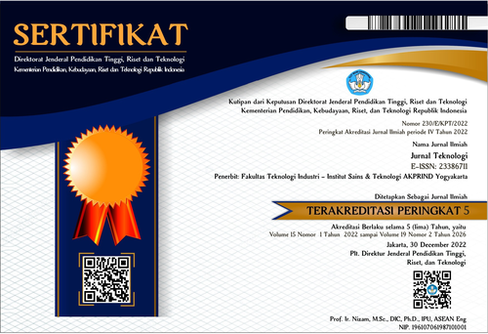STUDI PERBANDINGAN WARNA MARKER PADA TRACKING GERAK TANGAN BERBASIS VIDEO
Keywords:
tracking gerak tangan, teknik interaksi, interaksi manusia dan komputerAbstract
Kebutuhan akan metode interaksi dan komunikasi yang lebih alami antara user dan komputer adalah salah satu tuntutan dari perkembangan teknologi. Metode interaksi pada apilikasi Virtual Reality, Wearable Computer, dan Augmented Reality menyarankan bahwa perangkat interaksi tradisional seperti keyboard, mouse, dan joystik, tidak lagi nyaman digunakan.
Teknik interaksi berbasis visi komputer menjadi kandidat teknik interaksi yang bersifat alami. Teknik ini tidak membutuhkan kontak langsung pengguna dengan peralatan input, melainkan komputer menangkap gerakan pengguna melalui kamera video dan menginterpretasikannya. Tracking terhadap suatu marker pada sekuen video menjadi dasar teknik interaksi berbasis visi computer. Salah satu gerakan dari tubuh manusia yang sering digunakan sebagai alat komunikasi adalah gerakan tangan.
Pada penelitian ini, tracking dilakukan terhadap marker yang terpasang pada tiap posisi ujung jari dan telapak tangan. Dengan menggunakan tiga buah warna marker, yaitu merah, hijau, dan biru, hasil penelitian menunjukkan tidak terdapat perbedaan signifikan pada hasil tracking terhadap ketiga warna marker tersebut.
Downloads
References
Hassanpour, R., Birdal,A., 2008, “Region Based Hand Gesture Recognition”, Proceedings 16th International Conference in Central Europe on Computer Graphics, Visualization and Computer Vision 2008, Plzen-Bory, Czech Republic
Kim, H., dan Felner, D.W., 2004, “Interaction with hand gesture for a back projection wall”, CGI ’04: Computer Graphics International, IEEE Computer Society, Washigton, USA, 2004
Koike, H., Saito, Y., dan Ozawa, S., 2001, “Integrating paper and digital information on enhanceddesk: a method for realtime finger tracking on an augmented desk system”, ACM Transaction on Computer Human Interface. Vol. 8(4), hal. 307-322
Letessier, J., dan Berard, F., 2004, “Visual tracking of bare fingers for interactive surfaces”, UIST ’04: 17th Annual ACM Symposium on User Interface Software and Technology, NewYork, USA, 2004
Malik, S., dan Laszlo, J., 2004, “Visual touchpad: a two-handed gestural input device”, ICMI ’04: 6th International Conference on Multimodal Interfaces, ACM Press, NewYork, USA, 2004
Maggioni, C., 2004, “Gesturecomputer—history, design, and application”, Computer Vision and Human-Machine Interaction, Cambridge, hal. 312-325
O’Hagan, R., dan Zelinsky, A.,1997, “Finger track – a robust and realtime gesture interface”, AI ’97: 10th Australian Joint Conference on Artificial intelligence, Springer-Verlag, London, UK, 1997
O’Hagan, R., Zelinsky, A.,dan Rougeaux, S., 2002, “ Visual gesture interfaces for virtual environments”, Interacting with Computers, Vol. 4, hal 231-250
Oka, K., Sato, Y., dan Koike, H., 2002, “Real-time tracking of multiple fingertips and gesture recognition for augmented desk interface systems”, FGR ’02: Fifth IEEE International Conference on Automatic Face and Gesture Recognition, IEEE Computer Society, Washington DC, USA, 2002
Segen, J., dan Kumar, S., 1998, “Gesture VR: vision-based 3D interface for spatial interaction”, Sixth ACM International Conference on Multimedia, ACM Press, NewYork, USA, 1998
Usabiaga, J.H., 2005, “Global hand pose estimation using multiple camera ellipse tracking”, Thesis Master, Department of Computer Science , University Of Nevada, Reno, 1995
Downloads
Published
How to Cite
Issue
Section
License
Jurnal Teknologi provides immediate open access to its content in order of making research freely available to the public to support a global exchange of knowledge. All articles published in this journal are free for everyone to read and download, under licence CC BY SA.
Benefits of open access for the author, include:
- Free access for all users worldwide.
- Authors retain copyright to their work.
- Increased visibility and readership.
- No spatial constraints.




















